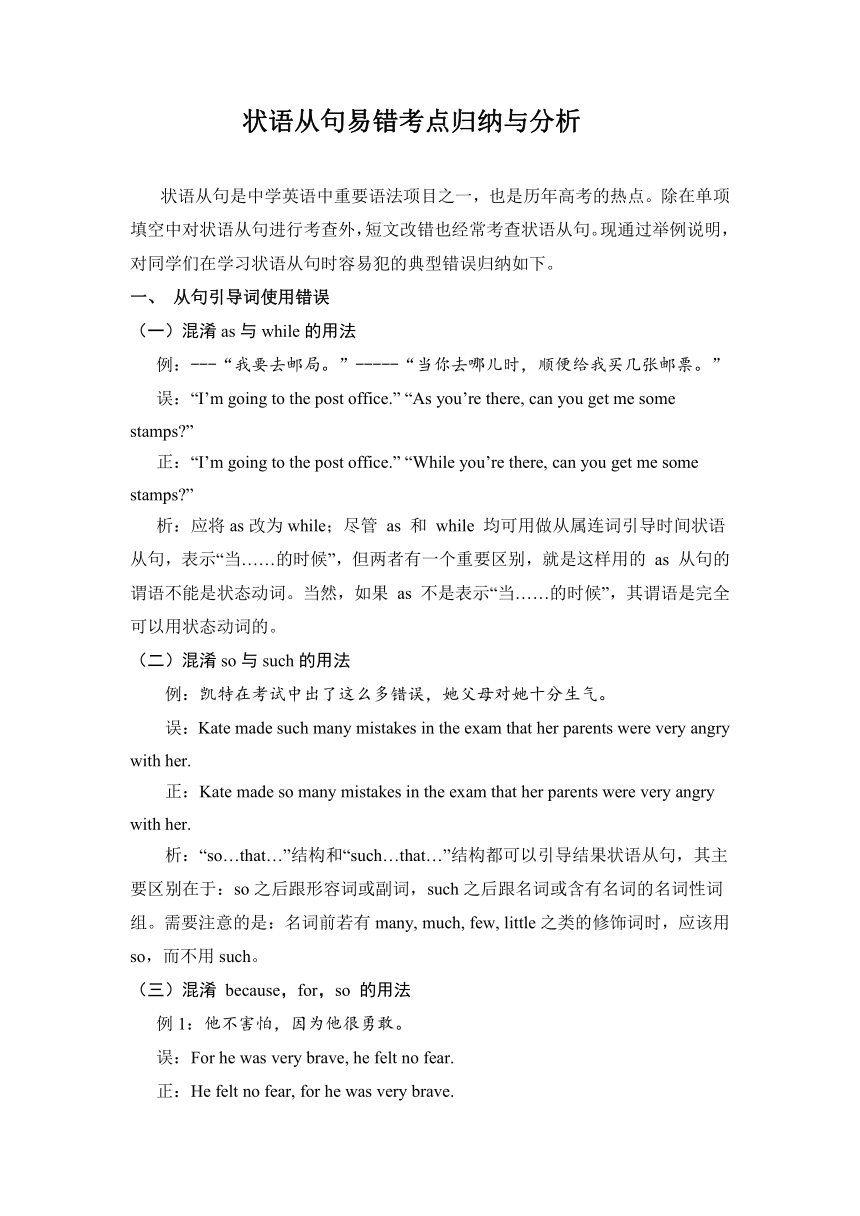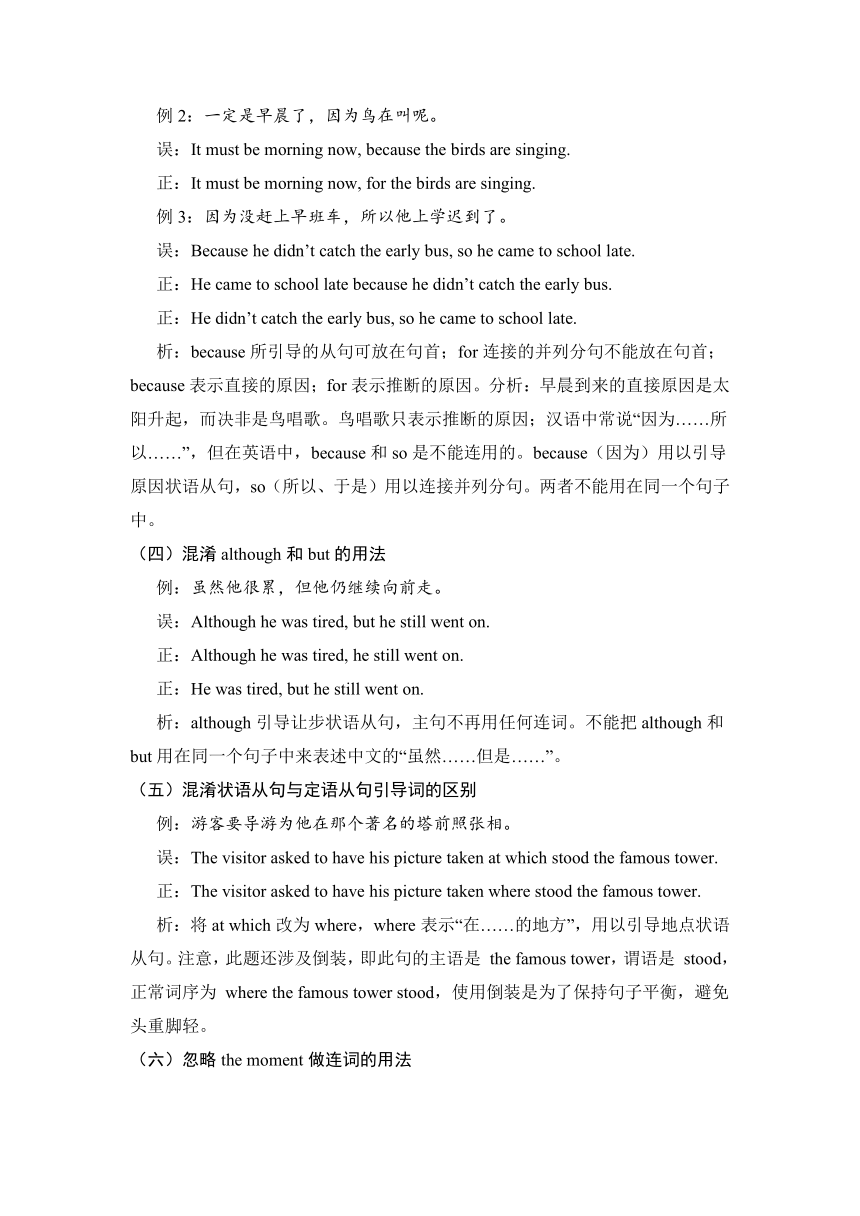2023届高三英语复习:状语从句易错考点归纳与分析讲义
文档属性
| 名称 | 2023届高三英语复习:状语从句易错考点归纳与分析讲义 |  | |
| 格式 | zip | ||
| 文件大小 | 28.1KB | ||
| 资源类型 | 教案 | ||
| 版本资源 | 通用版 | ||
| 科目 | 英语 | ||
| 更新时间 | 2022-08-01 17:11:43 | ||
图片预览


文档简介
状语从句易错考点归纳与分析
状语从句是中学英语中重要语法项目之一,也是历年高考的热点。除在单项填空中对状语从句进行考查外,短文改错也经常考查状语从句。现通过举例说明,对同学们在学习状语从句时容易犯的典型错误归纳如下。
一、 从句引导词使用错误
(一)混淆as与while的用法
例:---“我要去邮局。”-----“当你去哪儿时,顺便给我买几张邮票。”
误:“I’m going to the post office.” “As you’re there, can you get me some stamps ”
正:“I’m going to the post office.” “While you’re there, can you get me some stamps ”
析:应将as改为while;尽管 as 和 while 均可用做从属连词引导时间状语从句,表示“当……的时候”,但两者有一个重要区别,就是这样用的 as 从句的谓语不能是状态动词。当然,如果 as 不是表示“当……的时候”,其谓语是完全可以用状态动词的。
(二)混淆so与such的用法
例:凯特在考试中出了这么多错误,她父母对她十分生气。
误:Kate made such many mistakes in the exam that her parents were very angry with her.
正:Kate made so many mistakes in the exam that her parents were very angry with her.
析:“so…that…”结构和“such…that…”结构都可以引导结果状语从句,其主要区别在于:so之后跟形容词或副词,such之后跟名词或含有名词的名词性词组。需要注意的是:名词前若有many, much, few, little之类的修饰词时,应该用so,而不用such。
(三)混淆 because,for,so 的用法
例1:他不害怕,因为他很勇敢。
误:For he was very brave, he felt no fear.
正:He felt no fear, for he was very brave.
例2:一定是早晨了,因为鸟在叫呢。
误:It must be morning now, because the birds are singing.
正:It must be morning now, for the birds are singing.
例3:因为没赶上早班车,所以他上学迟到了。
误:Because he didn’t catch the early bus, so he came to school late.
正:He came to school late because he didn’t catch the early bus.
正:He didn’t catch the early bus, so he came to school late.
析:because所引导的从句可放在句首;for连接的并列分句不能放在句首;because表示直接的原因;for表示推断的原因。分析:早晨到来的直接原因是太阳升起,而决非是鸟唱歌。鸟唱歌只表示推断的原因;汉语中常说“因为……所以……”,但在英语中,because和so是不能连用的。because(因为)用以引导原因状语从句,so(所以、于是)用以连接并列分句。两者不能用在同一个句子中。
(四)混淆although和but的用法
例:虽然他很累,但他仍继续向前走。
误:Although he was tired, but he still went on.
正:Although he was tired, he still went on.
正:He was tired, but he still went on.
析:although引导让步状语从句,主句不再用任何连词。不能把although和but用在同一个句子中来表述中文的“虽然……但是……”。
(五)混淆状语从句与定语从句引导词的区别
例:游客要导游为他在那个著名的塔前照张相。
误:The visitor asked to have his picture taken at which stood the famous tower.
正:The visitor asked to have his picture taken where stood the famous tower.
析:将at which改为where,where表示“在……的地方”,用以引导地点状语从句。注意,此题还涉及倒装,即此句的主语是 the famous tower,谓语是 stood,正常词序为 where the famous tower stood,使用倒装是为了保持句子平衡,避免头重脚轻。
(六)忽略the moment做连词的用法
例:--“你记着是否还给玛丽所欠的钱了?” ---“我见到她的那一刻,就给她了”
误:--“Did you remember to give Mary the money you owed her ”
---“Yes, I gave it to her at the moment I saw her.”
正:---“Did you remember to give Mary the money you owed her ”
---“Yes, I gave it to her the moment I saw her.”
析:去掉at,at the moment用于现在时态中,意思是“此刻”,用于过去时态中,意思是“那时”;引导时间状语从句做连词要用the moment,意思是“一......就......” 类似地,the minute, the instant 也可用做连词,表示“一……就……” 的意思。
(七)误用“进行时+when+一般时”表示“正在……,就在这时”
例:刘老师进来时我们正在说笑。
误:We were talking and laughing while Miss Liu came in.
正:We were talking and laughing when Miss Liu came in.
析:when和while都有“当……的时候”之意,用于引导时间状语从句。但两者用法有所区别:while引导的从句中的谓语动词应该是延续性动词,而when引导从句中的谓语动词既可以是延续性动词,也可以是瞬间动词。
二、主从句时态一致的错误
(一)忽略“主将从现”的时态一致
例1:明天晚上如果不邀请李玲去参加聚会,我也不去。
误:I won’t go to the party tomorrow evening unless Li Ling will be invited.
正:I won’t go to the party tomorrow evening unless Li Ling is invited.
析:在when, as soon as, until等引导的时间状语从句和由if与unless引导的条件状语从句中,当主句是一般将来时时,从句常用一般现在时表示将来时间。
(二)忽略since从句中的时态一致
例1:自从我住在上海以来,就再也没有收到他的信了
误:I didn’t hear from him since I came to Shanghai.
正:I have not heard from him since I came to Shanghai.
例2:我戒烟有五年了
误:It has been five years since I smoked.
正:It has been five years since I stopped smoking..
析:since引导时间状语从句,表示“自从……以来”,主句用现在完成时,从句要用一般过去时;若since引导的状语从句的谓语动词是持续性动词或表示状态的动词的过去时时,则从句表示的时间是“从那持续动作或状态结束时算起”。
(三)忽略虚拟语气中主从句时态一致
例:这个女孩说话的样子好像她到过月球。
误:The girl talks as if she has been to the moon.
正:The girl talks as if she had been to the moon.
析:在as if (though)引导的方式状语从句中,若陈述情况与事实不符,或与事实相反,谓语动词要用虚拟语气,因此句中的has been应改为had been
(四)忽略no sooner...than.../hardly (scarcely)...when.中主从句的时态一致
例:他刚到这儿我就告诉了他这件事。
误:No sooner was he here than I told him about it.
正:No sooner had he been here than I told him about it.
析:no sooner...than..., hardly (scarcely)...when...等在意义上和as soon as,the moment...,the minute...,immediately...一样,引导时间状语从句时,表示"一……,就……"之意,但前者主句须用过去完成时,且主谓倒装,从句用一般过去时。
三、从句省略时的错误
(一)比较状语从句省略错误
例:这个人抽烟正如十年前他父亲那样。
误:The man smokes as much as his father 10 years ago.
正:The man smokes as much as his father did 10 years ago.
析:在比较状语从句中,比较状语从句中的谓语动词形式与主句不一致时,不能省略。因此句中的his father后应加上did。
(二)其他状语从句省略错误
例:问他为什么迟到,他一言不发。
误:He kept silent when asking why he was late.
正:He kept silent when (he was) asked why he was late.
析:在时间状语从句、条件状语从句中,从句主语与主句主语一致时,可省略从句的主语和部分谓语,但必须注意从句的语态,当从句为被动语态是省略后用过去分词短语做状语。
四、特殊句式与转换错误
(一)not…until…句式和转换的错误
例1:你可以在这儿等待直到有人来帮你。
误:You won’t wait here until help comes.
正:You will wait here until help comes.
例2:直到老师进来学生们才停止讲话
误:Not until the came in the students stopped talking.
正:Not until the came in did the students stop talking.
析:until用在肯定句,谓语动词通常是延续性动词,如stand, stay, talk, wait等,表示主句动作终止的时间;如果用在否定句,谓语动词通常是瞬间性动词,如open, start, leave, arrive, finish, stop等,强调主句动作开始的时间。故例1中的won’t应改为will;当Not until位于句首时,句子要倒装。其结构为:Not until+从句/表时间的词+助动词+(主句)主语+谓语+...。例2的错误恰好属于此类。
(二)as引导的让步状语从句的错误
例1:尽管他是一个科学家,他很谦虚。
误:A scientist as he is, he is very modest.
正:Scientist as he is, he is very modest.
例2:尽管他工作勤奋,他不能加薪。
误:Hard as did he work, he couldn't get a pay rise.
正:Hard as he worked, he couldn't get a pay rise.
析:以as, though引导的让步状语从句多用倒装语序,即把在从句中作表语的名词、形容词,或修饰谓语动词的副词放在从句谓语之前,但主谓语序任然为陈述语序;充当表语的单数可数名词前的不定冠词,充当表语的形容词和充当状语前的副词都要省略。
状语从句是中学英语中重要语法项目之一,也是历年高考的热点。除在单项填空中对状语从句进行考查外,短文改错也经常考查状语从句。现通过举例说明,对同学们在学习状语从句时容易犯的典型错误归纳如下。
一、 从句引导词使用错误
(一)混淆as与while的用法
例:---“我要去邮局。”-----“当你去哪儿时,顺便给我买几张邮票。”
误:“I’m going to the post office.” “As you’re there, can you get me some stamps ”
正:“I’m going to the post office.” “While you’re there, can you get me some stamps ”
析:应将as改为while;尽管 as 和 while 均可用做从属连词引导时间状语从句,表示“当……的时候”,但两者有一个重要区别,就是这样用的 as 从句的谓语不能是状态动词。当然,如果 as 不是表示“当……的时候”,其谓语是完全可以用状态动词的。
(二)混淆so与such的用法
例:凯特在考试中出了这么多错误,她父母对她十分生气。
误:Kate made such many mistakes in the exam that her parents were very angry with her.
正:Kate made so many mistakes in the exam that her parents were very angry with her.
析:“so…that…”结构和“such…that…”结构都可以引导结果状语从句,其主要区别在于:so之后跟形容词或副词,such之后跟名词或含有名词的名词性词组。需要注意的是:名词前若有many, much, few, little之类的修饰词时,应该用so,而不用such。
(三)混淆 because,for,so 的用法
例1:他不害怕,因为他很勇敢。
误:For he was very brave, he felt no fear.
正:He felt no fear, for he was very brave.
例2:一定是早晨了,因为鸟在叫呢。
误:It must be morning now, because the birds are singing.
正:It must be morning now, for the birds are singing.
例3:因为没赶上早班车,所以他上学迟到了。
误:Because he didn’t catch the early bus, so he came to school late.
正:He came to school late because he didn’t catch the early bus.
正:He didn’t catch the early bus, so he came to school late.
析:because所引导的从句可放在句首;for连接的并列分句不能放在句首;because表示直接的原因;for表示推断的原因。分析:早晨到来的直接原因是太阳升起,而决非是鸟唱歌。鸟唱歌只表示推断的原因;汉语中常说“因为……所以……”,但在英语中,because和so是不能连用的。because(因为)用以引导原因状语从句,so(所以、于是)用以连接并列分句。两者不能用在同一个句子中。
(四)混淆although和but的用法
例:虽然他很累,但他仍继续向前走。
误:Although he was tired, but he still went on.
正:Although he was tired, he still went on.
正:He was tired, but he still went on.
析:although引导让步状语从句,主句不再用任何连词。不能把although和but用在同一个句子中来表述中文的“虽然……但是……”。
(五)混淆状语从句与定语从句引导词的区别
例:游客要导游为他在那个著名的塔前照张相。
误:The visitor asked to have his picture taken at which stood the famous tower.
正:The visitor asked to have his picture taken where stood the famous tower.
析:将at which改为where,where表示“在……的地方”,用以引导地点状语从句。注意,此题还涉及倒装,即此句的主语是 the famous tower,谓语是 stood,正常词序为 where the famous tower stood,使用倒装是为了保持句子平衡,避免头重脚轻。
(六)忽略the moment做连词的用法
例:--“你记着是否还给玛丽所欠的钱了?” ---“我见到她的那一刻,就给她了”
误:--“Did you remember to give Mary the money you owed her ”
---“Yes, I gave it to her at the moment I saw her.”
正:---“Did you remember to give Mary the money you owed her ”
---“Yes, I gave it to her the moment I saw her.”
析:去掉at,at the moment用于现在时态中,意思是“此刻”,用于过去时态中,意思是“那时”;引导时间状语从句做连词要用the moment,意思是“一......就......” 类似地,the minute, the instant 也可用做连词,表示“一……就……” 的意思。
(七)误用“进行时+when+一般时”表示“正在……,就在这时”
例:刘老师进来时我们正在说笑。
误:We were talking and laughing while Miss Liu came in.
正:We were talking and laughing when Miss Liu came in.
析:when和while都有“当……的时候”之意,用于引导时间状语从句。但两者用法有所区别:while引导的从句中的谓语动词应该是延续性动词,而when引导从句中的谓语动词既可以是延续性动词,也可以是瞬间动词。
二、主从句时态一致的错误
(一)忽略“主将从现”的时态一致
例1:明天晚上如果不邀请李玲去参加聚会,我也不去。
误:I won’t go to the party tomorrow evening unless Li Ling will be invited.
正:I won’t go to the party tomorrow evening unless Li Ling is invited.
析:在when, as soon as, until等引导的时间状语从句和由if与unless引导的条件状语从句中,当主句是一般将来时时,从句常用一般现在时表示将来时间。
(二)忽略since从句中的时态一致
例1:自从我住在上海以来,就再也没有收到他的信了
误:I didn’t hear from him since I came to Shanghai.
正:I have not heard from him since I came to Shanghai.
例2:我戒烟有五年了
误:It has been five years since I smoked.
正:It has been five years since I stopped smoking..
析:since引导时间状语从句,表示“自从……以来”,主句用现在完成时,从句要用一般过去时;若since引导的状语从句的谓语动词是持续性动词或表示状态的动词的过去时时,则从句表示的时间是“从那持续动作或状态结束时算起”。
(三)忽略虚拟语气中主从句时态一致
例:这个女孩说话的样子好像她到过月球。
误:The girl talks as if she has been to the moon.
正:The girl talks as if she had been to the moon.
析:在as if (though)引导的方式状语从句中,若陈述情况与事实不符,或与事实相反,谓语动词要用虚拟语气,因此句中的has been应改为had been
(四)忽略no sooner...than.../hardly (scarcely)...when.中主从句的时态一致
例:他刚到这儿我就告诉了他这件事。
误:No sooner was he here than I told him about it.
正:No sooner had he been here than I told him about it.
析:no sooner...than..., hardly (scarcely)...when...等在意义上和as soon as,the moment...,the minute...,immediately...一样,引导时间状语从句时,表示"一……,就……"之意,但前者主句须用过去完成时,且主谓倒装,从句用一般过去时。
三、从句省略时的错误
(一)比较状语从句省略错误
例:这个人抽烟正如十年前他父亲那样。
误:The man smokes as much as his father 10 years ago.
正:The man smokes as much as his father did 10 years ago.
析:在比较状语从句中,比较状语从句中的谓语动词形式与主句不一致时,不能省略。因此句中的his father后应加上did。
(二)其他状语从句省略错误
例:问他为什么迟到,他一言不发。
误:He kept silent when asking why he was late.
正:He kept silent when (he was) asked why he was late.
析:在时间状语从句、条件状语从句中,从句主语与主句主语一致时,可省略从句的主语和部分谓语,但必须注意从句的语态,当从句为被动语态是省略后用过去分词短语做状语。
四、特殊句式与转换错误
(一)not…until…句式和转换的错误
例1:你可以在这儿等待直到有人来帮你。
误:You won’t wait here until help comes.
正:You will wait here until help comes.
例2:直到老师进来学生们才停止讲话
误:Not until the came in the students stopped talking.
正:Not until the came in did the students stop talking.
析:until用在肯定句,谓语动词通常是延续性动词,如stand, stay, talk, wait等,表示主句动作终止的时间;如果用在否定句,谓语动词通常是瞬间性动词,如open, start, leave, arrive, finish, stop等,强调主句动作开始的时间。故例1中的won’t应改为will;当Not until位于句首时,句子要倒装。其结构为:Not until+从句/表时间的词+助动词+(主句)主语+谓语+...。例2的错误恰好属于此类。
(二)as引导的让步状语从句的错误
例1:尽管他是一个科学家,他很谦虚。
误:A scientist as he is, he is very modest.
正:Scientist as he is, he is very modest.
例2:尽管他工作勤奋,他不能加薪。
误:Hard as did he work, he couldn't get a pay rise.
正:Hard as he worked, he couldn't get a pay rise.
析:以as, though引导的让步状语从句多用倒装语序,即把在从句中作表语的名词、形容词,或修饰谓语动词的副词放在从句谓语之前,但主谓语序任然为陈述语序;充当表语的单数可数名词前的不定冠词,充当表语的形容词和充当状语前的副词都要省略。
